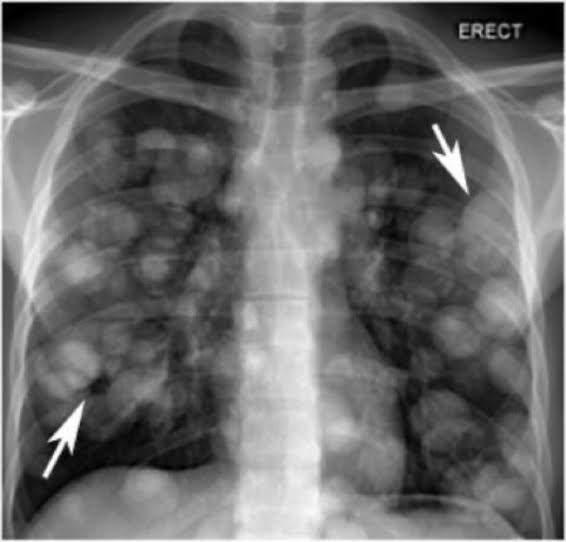• common causes of cannonball metastasis:
Lung cancer
Breast cancer
Renal cell carcinoma
Colorectal cancer
Melanoma
Ovarian cancer
Thyroid cancer
Bladder cancer
Prostate cancer
Sarcomas (e.g., osteosarcoma, chondrosarcoma)
Gastrointestinal cancers (e.g., stomach cancer, pancreatic cancer)
Testicular cancer
Head and neck cancers (e.g., nasopharyngeal carcinoma)
Neuroendocrine tumors
Lymphoma
Leukemia

Overview:
Cannonball metastasis, also known as cannonball lesions, refers to the appearance of multiple discrete pulmonary nodules scattered throughout the lungs, resembling cannonballs. This phenomenon signifies the spread of cancer from a primary tumor to the lungs, often indicating an advanced stage of disease progression. This article aims to provide a comprehensive overview of cannonball metastasis, including its causes, clinical significance, diagnostic approaches, and management strategies.
Understanding Cannonball Metastasis
Cannonball metastasis occurs when cancer cells break away from the primary tumor and travel through the bloodstream or lymphatic system to establish secondary tumors in the lungs. These metastatic nodules typically vary in size and distribution, appearing as round or oval-shaped masses on imaging studies such as chest X-rays or CT scans.
What are the Causes Of Cannonball metastasis?
Cannonball metastasis can arise from various primary malignancies, including but not limited to:
- Lung cancer
- Breast cancer
- Renal cell carcinoma
- Colorectal cancer
- Melanoma
- Ovarian cancer
- Thyroid cancer
The propensity for certain cancers to metastasize to the lungs depends on factors such as tumor biology, vascular supply, and anatomical location.
Clinical Significance
The presence of cannonball metastasis in the lungs often indicates advanced-stage cancer with a poorer prognosis. These metastatic lesions can compromise pulmonary function, leading to symptoms such as cough, dyspnea (shortness of breath), chest pain, and hemoptysis (coughing up blood). Additionally, the widespread dissemination of cancer cells throughout the lungs may limit treatment options and contribute to disease progression.
Diagnostic Approach
Diagnosing cannonball metastasis involves a thorough evaluation of the patient’s medical history, physical examination, and imaging studies. Chest X-rays, CT scans, and positron emission tomography (PET) scans are instrumental in detecting and characterizing pulmonary nodules. Further investigations, such as biopsy or bronchoscopy, may be necessary to confirm the presence of metastatic disease and determine the underlying primary tumor.
Management of Cannonball metastasis:
The management of cannonball metastasis hinges on several factors, including the primary tumor type, extent of metastatic spread, and overall patient health. Treatment modalities may encompass:
- Systemic therapy: Chemotherapy, targeted therapy, or immunotherapy aimed at controlling tumor growth and metastatic progression.
- Radiation therapy: Utilized for palliative purposes to alleviate symptoms and improve quality of life.
- Surgical intervention: In select cases with limited metastatic burden and favorable prognostic factors, surgical resection of pulmonary metastases may be considered to achieve disease control and potentially prolong survival.
Prognosis
The prognosis for patients with cannonball metastasis depends on various factors, including the primary tumor type, extent of metastatic involvement, response to treatment, and overall patient health. Despite advances in cancer therapy, cannonball metastasis often signifies advanced-stage disease associated with a diminished prognosis and reduced survival rates.
Conclusion
Cannonball metastasis represents a formidable challenge in the realm of oncology, heralding advanced-stage cancer with significant implications for patient management and prognosis. Through early detection, comprehensive evaluation, and multidisciplinary collaboration, healthcare professionals strive to optimize treatment outcomes and enhance the quality of life for individuals affected by this formidable manifestation of metastatic disease. Continued research efforts aimed at elucidating the underlying mechanisms of cancer metastasis hold promise for advancing our understanding and improving therapeutic strategies in the fight against cancer.
Reference :
- Cannon-ball pulmonary metastases as a presenting feature of stomach cance https://www.ncbi.nlm.nih.gov/pmc/articles/PMC4429404/


Pingback: Home - Common health conditions - ECG Oxford